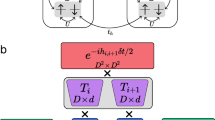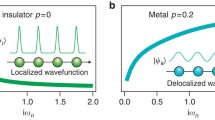Abstract
Arising from: F. Giustino, M. L. Cohen & S. G. Louie Nature 452, 975–978 (2008)10.1038/nature06874
One of the possible mechanisms of high transition temperature (Tc) superconductivity is Cooper pairing with the help of bosons, which change the slope of the electronic dispersion as observed by photoemission. Giustino et al.1 calculated that in the high temperature superconductor La1.85Sr0.15CuO4 crystal lattice vibrations (phonons) should have a negligible effect on photoemission spectra and concluded that phonons do not have an important role. Here we show that the calculations used by Giustino et al.1 do not reproduce the huge influence of electron–phonon coupling on important phonons observed in experiments. Thus, we would similarly expect that these calculations do not explain the role of electron–phonon coupling for the electronic dispersion.

Similar content being viewed by others
References
Giustino, F., Cohen, M. L. & Louie, S. G. Small phonon contribution to the photoemission kink in the copper oxide superconductors. Nature 452, 975–978 (2008)
Reznik, D. et al. Electron–phonon coupling reflecting dynamic charge inhomogeneity in copper oxide superconductors. Nature 440, 1170–1173 (2006)
Reznik, D. et al. Electron–phonon anomaly related to charge stripes: Static stripe phase versus optimally doped superconducting La1. 85Sr0. 15CuO4 . J. Low Temp. Phys. 147, 353–364 (2007)
Pintschovius, L. et al. Oxygen phonon branches in YBa2Cu3O7 . Phys. Rev. B 69, 214506 (2004)
Uchiyama, H. et al. Softening of Cu-O bond stretching phonons in tetragonal HgBa2CuO4+δ . Phys. Rev. Lett. 92, 197005 (2004)
Pintschovius, L., Reznik, D. & Yamada, K. Oxygen phonon branches in overdoped La1. 7Sr0. 3Cu3O4 . Phys. Rev. B 74, 174514 (2006)
Zhou, X. J. et al. Universal nodal Fermi velocity. Nature 423, 398 (2003)
Heid, R., Bohnen, K.-P., Zeyher, R. & Manske, D. Momentum dependence of the electron-phonon coupling and self-energy effects in superconducting YBa2Cu3O7 within the local density approximation. Phys. Rev. Lett. 100, 137001 (2008)
Rösch, O. & Gunnarsson, O. Electron–phonon interaction in the three-band model. Phys. Rev. B 70, 224518 (2004)
Horsch, P. & Khaliullin, G. Doping dependence of density response and bond-stretching phonons in cuprates. Physica B 359–361, 620–622 10.1016/j.physb.2005.01.170(2005)
Iwasawa, H. et al. An isotopic fingerprint of electron–phonon coupling in high-T c cuprates. Preprint at <http://arxiv.org/abs/0808.1323> (2008)
Bohnen, K.-P., Heid, R. & Krauss, M. Phonon dispersion and electron–phonon interaction for YBa2Cu3O7 from first-principles calculations. Europhys. Lett. 64, 104–110 (2003)
Author information
Authors and Affiliations
PowerPoint slides
Rights and permissions
About this article
Cite this article
Reznik, D., Sangiovanni, G., Gunnarsson, O. et al. Photoemission kinks and phonons in cuprates. Nature 455, E6–E7 (2008). https://doi.org/10.1038/nature07364
Received:
Accepted:
Issue Date:
DOI: https://doi.org/10.1038/nature07364
- Springer Nature Limited
This article is cited by
-
A New Landscape of Multiple Dispersion Kinks in a High-T c Cuprate Superconductor
Scientific Reports (2017)
-
Phonon-Mediated Electron–Phonon Interaction in Hubbard–Holstein Model
Journal of Low Temperature Physics (2016)
-
Relevance of the Phonon-Coupling Mode on the Superconducting Pairing Interaction of La2−x Sr x CuO4
Journal of Superconductivity and Novel Magnetism (2011)
-
Strength of the spin-fluctuation-mediated pairing interaction in a high-temperature superconductor
Nature Physics (2009)





